List of emperors of the Qing dynasty
The Qing dynasty (1644–1912) was the last imperial dynasty of China. It was officially founded in 1636 in what is now Northeast China, but only succeeded the Ming dynasty in China proper in 1644. The Qing period ended when the imperial clan (surnamed Aisin Gioro) abdicated in February 1912, a few months after a military uprising had started the Xinhai Revolution (1911) that led to the foundation of the Republic of China (1912–1949).
Nurhaci (1559–1626), khan of the Jurchens, founded the "Later Jin dynasty" in 1616 in reference to the Jurchen-led Jin dynasty (1115–1234) that had once reigned over north China. His son and successor Hong Taiji (1592–1643) renamed his people "Manchu" in 1635 and changed the name of Nurhaci's state from "Later Jin" to "Qing" in 1636. Hong Taiji was the real founder of Qing imperial institutions. He was the first to adopt the title of "emperor" (huangdi) and founded an Imperial Ancestral Temple in the Qing capital Mukden in 1636. After the Qing captured Beijing in 1644 and appropriated the Ming Ancestral Temple, from 1648 on, Nurhaci was worshiped there as Qing "Taizu", a temple name reserved for dynastic founders.
Like their Ming (1368–1644) predecessors—but unlike the emperors of earlier dynasties like the Han (206 BCE–220 CE), Tang (618–907), and Song (960–1276)—Qing emperors used only one era name ("Shunzhi", "Qianlong", "Guangxu", etc.) for their entire reign, and are most commonly known by that name. Starting with Nurhaci, there were thirteen Qing rulers. Following the capture of Beijing in 1644, the Shunzhi Emperor (r. 1643–1661) became the first of the eleven Qing sovereigns to rule over China proper. At 61 years, the reign of the Kangxi Emperor (r. 1661–1722) was the longest, though his grandson, the Qianlong Emperor (r. 1735–1796), would have reigned even longer if he had not purposely ceded the throne to the Jiaqing Emperor (r. 1796–1820) in order not to reign longer than his grandfather. Qing emperors succeeded each other from father to son until the Tongzhi Emperor (r. 1861–1874), the 11th Qing ruler, died childess in 1874. The last two emperors were chosen by Empress Dowager Cixi from other branches of the imperial clan.
Succession

Unlike the Ming emperors, who named their eldest legitimate son heir apparent whenever possible and forbade other sons from participating in politics, the Qing monarchs did not choose their successors according to primogeniture.[2] When in 1622 Nurhaci (1559–1626) was asked which one of his sons he had chosen to succeed him as khan of the Jurchens, he refused to answer, telling his sons that they should determine after his death who among them was the most qualified leader.[2] His answer reflected the fact that in Jurchen society, succession as tribal chieftain was usually determined by merit, not descent.[2] When Nurhaci died in 1626, a committee of Manchu princes selected Hong Taiji (1592–1643) as his successor.[3] Hong Taiji's death in 1643 caused another succession crisis, because many of Nurhaci's other sons appeared to be qualified leaders. As a compromise, the Manchu princes chose Hong Taiji's four-year-old son Fulin (the Shunzhi Emperor, r. 1643–1661) as his successor, marking the adoption of father-son succession in the Qing imperial line.[4]
The Shunzhi Emperor, who died of smallpox in 1661, chose his third son Xuanye as successor because he had survived smallpox.[5] That child reigned as the Kangxi Emperor (r. 1661–1722), who for the first time in Qing history followed the Chinese habit of primogeniture and appointed his eldest son Yinreng (1674–1725) as heir apparent.[6] The heir apparent was removed twice because of his extravagance and abhorrent behavior, which included an attempt to assassinate the emperor.[7] After Yinreng was demoted for good in 1712, the emperor refused to name an heir.[8] Because Qing policy forced imperial princes to reside in the capital Beijing, many princes became involved in politics, and the Kangxi succession became particularly contested.[9] After the Kangxi Emperor's death in 1722, his fourth son Yinzhen (1678–1735) emerged as victor and reigned as the Yongzheng Emperor, but his legitimacy was questioned for years after his accession.[10]
To avoid such struggles in the future, the Yongzheng Emperor designed a system by which the living emperor would choose his successor in advance and on merit, but would keep his choice secret until his deathbed.[9] The name of the future emperor was sealed in a casket that was hidden behind a panel in the rafters of the Qianqing Palace inside the Forbidden City.[9] As successor, the Yongzheng Emperor chose his fifth son Hongli (1711–1799), who himself selected his 15th son Yongyan. The latter, who reigned as the Jiaqing Emperor (r. 1796–1820), chose his successor Minning (1782–1850) in 1799, but only read his testament shortly before dying.[11]
When the Tongzhi Emperor died heirless in 1874, his mother Empress Dowager Cixi was the one who selected the next emperor. But instead of making the deceased emperor adopt an heir from the generation below himself (in this case this would have been a nephew of the Tongzhi Emperor) as the rules of imperial succession dictated, she picked one from the same generation.[12] The new emperor was Zaitian (the Guangxu Emperor; 1871–1908), the son of Prince Chun, a half-brother of Empress Dowager Cixi's late husband, the Xianfeng Emperor (r. 1850–1861).[11] She assured her opponents that as soon as the new emperor had a son, he would be adopted into the Tongzhi Emperor's line.[12] However, as the Guangxu Emperor died heirless too, Empress Dowager Cixi also chose his successor, Puyi, in 1908.[11]
Regents and empresses dowager
Qing succession and inheritance policies made it difficult for empresses and their relatives to build power at court, as they had in the Han dynasty for example.[13] Threats to imperial power usually came from within the imperial clan.[14] When the young Fulin was chosen to succeed his father Hong Taiji in September 1643, two "prince regents" were selected for him: Hong Taiji's half-brother Dorgon (1612–1650) and Nurhaci's nephew Jirgalang (1599–1655). Soon after the Manchus had seized Beijing under Dorgon's leadership in May 1644, Dorgon came to control all important government matters.[15] Official documents referred to him as "Imperial Uncle Prince Regent" (Huang shufu shezheng wang 皇叔父攝政王), a title that left him one step short of claiming the throne for himself.[16] A few days after his death, he received a temple name (Chengzong 成宗) and a honorific posthumous title (Yi Huangdi 義皇帝, "Righteous Emperor"), and his spirit tablet was placed in the Imperial Ancestral Temple next to those of Nurhaci and Hong Taiji.[17] In early March 1651 after Dorgon's supporters had been purged from the court, these titles were abrogated.[18]
.jpg)
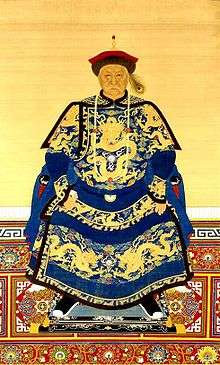
The reign of the Shunzhi Emperor ended when he died of smallpox in 1661 at the age of 22.[19] His last will—which was tampered and perhaps even forged by its beneficiaries—appointed four co-regents for his son and successor the six-year-old Xuanye, who was to reign as the Kangxi Emperor.[20] All four were Manchu dignitaries who had supported the Shunzhi Emperor after the death of Dorgon, but their Manchu nativist measures reversed many of the Shunzhi Emperor's own policies.[21] The "Oboi regency", named after the most powerful of the four regents, lasted until 1669, when the Kangxi Emperor started his personal rule.[22]
For almost 200 years, the Qing Empire was governed by adult emperors. In the last fifty years of the dynasty—from the death of the Xianfeng Emperor in 1861 to the final abdication of the child emperor Puyi in 1912—the imperial position again became vulnerable to the power of regents, empress dowagers, imperial uncles, and eunuchs.[23] Empress Dowager Cixi (1835–1908), a spouse of the Xianfeng Emperor, came to power through a coup that ousted eight regents who had been named by her husband. She controlled the government during the reigns of the Tongzhi (r. 1861–1875) and Guangxu (r. 1875–1908) emperors. From 1861 onwards, she was officially co-regent with Empress Dowager Ci'an, but her political role increased so much that within a few years she was taking charge of most government matters. She became sole regent in 1881 after the death of Empress Dowager Ci'an.[12] With the assistance of eunuchs and Manchu princes, she remained regent until March 1889, when she finally let the Guangxu Emperor rule personally (he was then 28 years old).[24] After she intervened to end the Hundred Days' Reform in September 1898, she had the emperor put under house arrest and held the reins of the Qing government until her death in 1908.[25] She was the one who chose the Guangxu Emperor's successor, the child Puyi, whose regent was his father Prince Chun.
Multiple appellations
Like the emperors of previous dynasties, Qing monarchs were known by several names, which were to be used in different circumstances.
Era name

An emperor's era name or reign name was chosen at the beginning of his reign to reflect the political concerns of the court at the time.[26] A new era name became effective on the first day of the Chinese New Year after that emperor's accession, which fell between 21 January and 20 February (inclusively) of the Gregorian calendar.[27] Even if an emperor died in the middle of the year, his era name was used for the rest of that year before the next era officially began.[28] Because of this discrepancy between the day of an emperor's accession and the first day of his reign name, most emperors first reigned under their predecessor's era name.
Like the emperors of the Ming dynasty, Qing monarchs used only one reign name and are usually known by that name, as when we speak of the "Qianlong Emperor" (r. 1735–1795) or the "Guangxu Emperor" (r. 1875–1908).[29] Strictly speaking, referring to the Qianlong Emperor simply as "Qianlong" is wrong, because "Qianlong" was not that emperor's own name but that of his reign era. For convenience sake, however, many historians still choose to call him Qianlong (though not "Emperor Qianlong").[30] The only Qing emperors who are not commonly known by their reign name are the first two: Nurhaci (r. 1616–1626), who is known by his personal name, and his son and successor Hong Taiji (r. 1626–1643), whose name was a title meaning "prince Hong". Hong Taiji was the only Qing emperor to use two era names (see table).[31]
Reign names are usually left untranslated, but some scholars occasionally gloss them when they think these names have a special significance. Historian Pamela Crossley explains that Hong Taiji's first era name Tiancong 天聰 (abkai sure in Manchu) referred to a "capacity to transform" supported by Heaven, and that his second one Chongde 崇德 (wesihun erdemungge) meant the achievement of this transformation.[31] The practice of translating reign names is not new: Jesuits who resided at the Qing court in Beijing in the 18th century translated "Yongzheng"—or its Manchu version "Hūwaliyasun tob"—as Concordia Recta.[32]
An era name was used to record dates, usually in the format "Reign-name Xth year, Yth month, Zth day" (sometimes abridged as X/Y/Z by modern scholars). A Qing emperor's era name was also used on the coins that were cast during his reign.[33] Unlike in the Ming dynasty, the characters used in Qing reign names were taboo, that is, the characters contained in it could no longer be used in writing throughout the empire.[34]
Personal name
As in previous dynasties, the emperor's personal name became taboo after his accession.[35] The use of xuan 玄 ("mysterious", "profound") in the Kangxi Emperor's personal name Xuanye (玄燁), for example, forced printers of Buddhist and Daoist books to replace this very common character with yuan 元 in all their books.[36] Even the Daodejing, a Daoist classic, and the Thousand Character Classic, a widely used primer, had to be reprinted with yuan instead of xuan.[36]
When the Yongzheng Emperor, whose generation was the first in which all imperial sons shared a generational character as in Chinese clans, acceded the throne, he made all his brothers change the first character of their name from "Yin" (胤) to "Yun" (允) to respect the taboo.[37] Citing fraternal solidarity, his successor, the Qianlong Emperor, simply removed one stroke from his own name and let his brothers keep their own.[38]
Later emperors found other ways to diminish the inconvenience of naming taboos. The Jiaqing Emperor (r. 1796–1820), whose personal name was Yongyan (永琰), replaced the very common first character of his personal name (yong 永, which means "forever") with an obscure one (顒) with the same pronunciation.[37] The Daoguang Emperor (r. 1820–1850) removed the character for "cotton" (棉) from his name and decreed that his descendants should henceforth all omit one stroke from their name.[39]
In accordance with Manchu practice, Qing emperors rarely used their clan name Aisin Gioro.[40]
Posthumous titles
Temple name
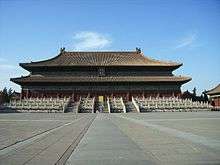
After their deaths, the emperors were given a temple name and a honorific name under which they would be worshiped at the Imperial Ancestral Temple. On the spirit tablets that were displayed there, the temple name was followed by the honorific name, as in "Shizu Zhang huangdi" for the Shunzhi Emperor and "Taizong Wen huangdi" for Hong Taiji. As dynastic founder, Nurhaci ("Taizu") became the focal ancestor in the main hall of the temple.[41] The earlier paternal ancestors of the Qing imperial line were worshiped in a back hall.[41] Historical records like the Veritable Records (traditional Chinese: 實錄; simplified Chinese: 实录; pinyin: Shílù), which were compiled at the end of each reign, retrospectively referred to emperors by their temple names.
Hong Taiji created the Qing ancestral cult in 1636 when he assumed the title of emperor.[42] Taking the Chinese imperial cult as a model, he named his main paternal ancestors "kings" and built an Imperial Ancestral Temple in his capital Mukden to offer sacrifices to them.[42] When the Qing took control of Beijing in 1644, Prince Regent Dorgon had the Aisin Gioro ancestral tablets installed in what had been the Ming ancestral temple.[41] In 1648 the Qing government bestowed the title of "emperor" to these ancestors and gave them the honorific posthumous names and temple names by which they were known for the rest of the dynasty.[42] Nurhaci was identified retrospectively as Taizu ("grand progenitor"), the usual name given to a dynasty's first emperor.[43] This is why Nurhaci is considered as the first Qing ruler even if he was never emperor in his lifetime. Taizong was the usual name for the second emperor of a dynasty, and so Hong Taiji was canonized as Qing Taizong.[44]
The last emperor of a dynasty usually did not receive a temple name because his descendants were no longer in power when he died, and thus could not perpetuate the ancestral cult.[45] Puyi, the last Qing monarch, reigned as the Xuantong Emperor from 1908 to 1912, but did not receive a temple name.[46]
Honorific posthumous name
After death emperors were given an honorific posthumous title that reflected their ruling style. Nurhaci's posthumous name was originally the "Martial Emperor" (武皇帝 wǔ huángdì)—to reflect his military exploits—but in 1662 it was changed to "Highest Emperor" (高皇帝 gāo huángdì), that is, "the emperor from whom all others descend."[47] Hong Taiji's posthumous name, the "Emperor of Letters" (M.: šu hūwangdi; Ch.: 文皇帝 wén huángdì), was chosen to reflect the way in which he metamorphosed Qing institutions during his reign.[31]
List of emperors
This is a complete list of the emperors of the Qing dynasty. These emperors were usually enthroned on an auspicious day soon after the death of the previous monarch. With two exceptions (Jiaqing and Guangxu), they reigned under their predecessor's era name until the following New Year.[48] The date that appears under "Dates of reign" indicates the first day of the lunisolar year following the death of the previous emperor, which is when the new emperor's era name came into use. The number of years indicated in the same column is the number of years in which that era name was used. Because of discrepancies between the western and the Chinese calendar, this number does not perfectly correspond to the number of years in which an emperor was on the throne.
Since posthumous titles and temple names were often shared by emperors of different dynasties, to avoid confusion they are usually preceded by the dynastic name. The Qianlong emperor, for instance, should be referred to as Qing Gaozong rather than just Gaozong. The table, however, omits the term "Qing", because it is understood that all the emperors listed were from that dynasty. Because each emperor's posthumous name was extremely long—that of the Shunzhi Emperor, for instance, was "Titian longyun dingtong jianji yingrui qinwen xianwu dade honggong zhiren chunxiao Zhang huangdi" 體天隆運定統建極英睿欽文顯武大德弘功至仁純孝章皇帝—the table only shows the short form.[49]
Except for the last emperor Puyi, all portraits are official court portraits. All dates in the table are in the Gregorian calendar.
| # | Name by which most commonly known (birth–death) [50] |
Portrait | Dates of reign [50] |
Given name [50] |
Era name (Chinese– Manchu) [51] |
Posthumous name (Chinese– Manchu) [51] |
Temple name [50] |
Notes |
|---|---|---|---|---|---|---|---|---|
| 1 | Nurhaci (21 February 1559– 30 September 1626) |
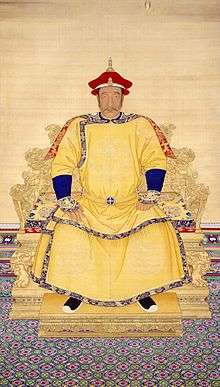 |
1616 ↓ 1626 |
Nurhaci 努爾哈赤 (pinyin: Nǔ'ěrhāchì) |
Tiānmìng* 天命 Abkai fulingga |
Gāodì# 高帝 Dergi |
Tàizǔ 太祖 |
* Tianming was not used as an era name at the time.[52] # Nurhaci's posthumous name was originally the "Martial Emperor" (武皇帝 Wu huangdi; Manchu: Horonggo), but in 1662 it was changed to "Highest Emperor" (高皇帝 Gao huangdi).[47] |
| 2 | Hong Taiji (28 November 1592– 21 September 1643) |
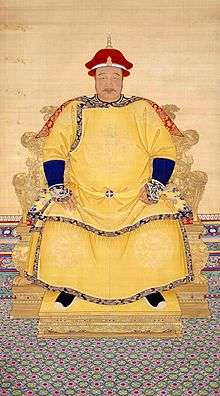 |
1626 ↓ 1643 |
皇太极 (pinyin: huángtàijí) |
Tiāncōng# 天聰 Abkai sure (1627–1636); Chóngdéx |
Wéndì 文帝 Genggiyen Su |
Tàizōng 太宗 |
* "Hong Taiji" means "Prince Hong" and was probably a title, not a name.[53] In some western historical studies, Hong Taiji is erroneously called Abahai (阿巴海).[54] # Tiancong may not have been an era name.[55] x Hong Taiji declared a change from Tiancong to Chongde in May 1636 when he declared himself "emperor" of the newly named "Qing" dynasty.[48] |
| Dorgon* (17 November 1612– 31 December 1650) |
.jpg) |
1643 ↓ 1650 |
Dorgon 多爾袞 (pinyin: Duōěrgǔn) |
none* | Yìdì* 義帝 |
Chéngzōng* 成宗 |
* Dorgon controlled Qing government during the early Shunzhi reign, but he was never officially named emperor and never had his own era name. Although he was granted posthumous titles in 1651 a few days after his death, they were abolished later that year.[56] | |
| 3 | Shunzhi Emperor (15 March 1638– 5 February 1661) |
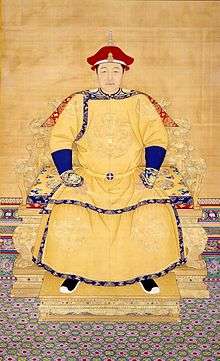 |
(8 February) 1644* ↓ 1661 (18 years) |
Fúlín 福臨 |
Shùnzhì 順治 Ijishūn dasan |
Zhāngdì 章帝 Eldembure |
Shìzǔ 世祖 |
* From 1643 to 1650, political power was in Prince Regent Dorgon's hands (see previous row). The Shunzhi Emperor started to rule personally in 1651. |
| 4 | Kangxi Emperor (4 May 1654– 20 December 1722) |
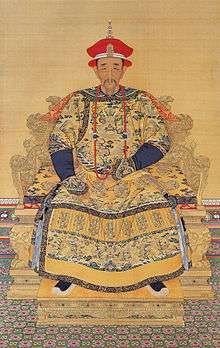 |
(18 February) 1662* ↓ 1722 (61 years) |
Xuányè 玄燁 |
Kāngxī 康熙 Elhe taifin |
Réndì 仁帝 Gosin |
Shèngzǔ 聖祖 |
* From 1662 to 1669, political power lay in the hands of four regents, the most powerful of which was Oboi.[22] |
| 5 | Yongzheng Emperor (13 December 1678– 8 October 1735) |
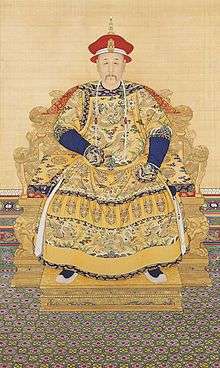 |
(5 February) 1723 ↓ 1735 (13 years) |
Yìnzhēn 胤禛 |
Yōngzhèng 雍正 Hūwaliyasun tob |
Xiàndì 憲帝 Temgetulehe |
Shìzōng 世宗 |
|
| 6 | Qianlong Emperor (25 September 1711– 7 February 1799) |
 |
(12 February) 1736 ↓ 1796* (60 years) |
Hónglì 弘曆 |
Qiánlóng 乾隆 Abkai wehiyehe |
Chúndì 純帝 Yongkiyangga |
Gāozōng 高宗 |
* In an act of filial piety to ensure that he would not reign longer than his grandfather Kangxi, the Qianlong emperor retired on 8 February 1796—the last day of that year in the Chinese calendar—and took the title Emperor Emeritus.[48] However, he remained the ultimate authority until his death in 1799. |
| 7 | Jiaqing Emperor (13 November 1760– 2 September 1820) |
 |
(9 February)* 1796 ↓ 1820 (25 years) |
Yóngyǎn# 顒琰 |
Jiāqìng 嘉慶 Saicungga fengšen |
Ruìdì 睿帝 Sunggiyen |
Rénzōng 仁宗 |
* The first day of the Jiaqing era was also the first day of this emperor's reign, because his father retired on the last day of the previous year. Jiaqing was not truly in power until Qianlong's death in 1799. # His name before his enthronement was Yŏngyăn 永琰, but he changed the first character to the homophonous 顒 because a naming taboo on the common character yong 永 ("forever") would have been too inconvenient.[37] |
| 8 | Daoguang Emperor (16 September 1782– 25 February 1850) |
|
(3 February) 1821 ↓ 1850 (30 years) |
Mínníng* 旻寧 |
Dàoguāng 道光 Doro eldengge |
Chéngdì 成帝 Šanggan |
Xuānzōng 宣宗 |
* His name had been Miánníng 綿寧, but he changed it to Minning when he acceded the throne because a naming taboo on the common character mian 綿 ("cotton") would have been too inconvenient.[37] |
| 9 | Xianfeng Emperor (17 July 1831– 22 August 1861) |
 |
(1 February) 1851 ↓ 1861 (11 years) |
Yìzhǔ 奕詝 |
Xiánfēng 咸豐 Gubci elgiyengge |
Xiǎndì 顯帝 Iletu |
Wénzōng 文宗 |
|
| 10 | Tongzhi Emperor (27 April 1856– 12 January 1875) |
 |
(30 January) 1862 ↓ 1875 (13 years) |
Zǎichún 載淳 |
Tóngzhì* 同治 Yooningga dasan |
Yìdì 毅帝 Filingga |
Mùzōng 穆宗 |
* Court officials had first decided to use the reign name "Qixiang" 祺祥 (Qíxiáng), but they changed their minds and settled on "Tongzhi" before the beginning of the following New Year, so "Qixiang" was never used.[57] |
| 11 | Guangxu Emperor (14 August 1871– 14 November 1908) |
 |
(6 January) 1875 ↓ 1908 (34 years) |
Zǎitián 載湉 |
Guāngxù 光緒 Badarangga doro |
Jǐngdì 景帝 Ambalinggū |
Dézōng 德宗 |
|
| 12 | Xuantong Emperor (7 February 1906– 17 October 1967) |
 |
(22 January) 1909 ↓ (17 February) 1912* (3 years) |
Pǔyí 溥儀 also known as Henry |
Xuāntǒng 宣統 Gehungge yoso |
none given | none given | *The "Articles of Favorable Treatment of the Emperor of Great Qing after His Abdication" (清帝退位 優待條件) signed by Puyi's aunt Empress Dowager Longyu, Yuan Shikai, and the provisional government of the Republic of China in Nanjing allowed Puyi to retain his title of "emperor" until 1924.[58] |
See also
References
Citations
- ↑ Rawski 1998, pp. 54 (analysis of the painting) and 102 ("secret succession").
- 1 2 3 Rawski 1998, p. 98.
- ↑ Roth Li 2002, pp. 51–2.
- ↑ Rawski 1998, pp. 98–99.
- ↑ Spence 2002, p. 125.
- ↑ Wu 1979, p. 31.
- ↑ Wu 1979, pp. 118–20 and 154–5.
- ↑ Rawski 1998, p. 101–2.
- 1 2 3 Rawski 1998, p. 102.
- ↑ Zelin 2002, pp. 185–86.
- 1 2 3 Rawski 1998, p. 103.
- 1 2 3 Fang 1943b, p. 297.
- ↑ de Crespigny 2007, pp. 1217–18 (role of empresses and their clans in the Han dynasty); Naquin 2000, p. 346 (rest of the information).
- ↑ Rawski 1998, pp. 96–103.
- ↑ Roth Li 2002, p. 71.
- ↑ Wakeman 1985, p. 861.
- ↑ Fang 1943a, p. 217 (Chengzong and Yi huangdi); Oxnam 1975, pp. 47–48 (imperial funeral, "Righteous Emperor").
- ↑ Oxnam 1975, p. 75.
- ↑ Dennerline 2002, p. 118.
- ↑ Historians widely agree that the Shunzhi Emperor's will was either deeply modified or forged altogether. See for instance Oxnam 1975, pp. 62–63 and 205-7; Kessler 1976, p. 20; Wakeman 1985, p. 1015; Dennerline 2002, p. 119; and Spence 2002, p. 126.
- ↑ Oxnam 1975, p. 48.
- 1 2 Spence 2002, p. 133.
- ↑ Naquin 2000, p. 346.
- ↑ Fang 1943b, p. 298.
- ↑ Fang 1943b, pp. 298–99.
- ↑ Wilkinson 2012, p. 515.
- ↑ Wilkinson 2012, p. 512.
- ↑ Wilkinson 2012, pp. 513–14.
- ↑ Wilkinson 2012, pp. 182 and 512.
- ↑ Elliott 2001, p. xii ["Strictly speaking it is proper to refer to him as 'the Qianlong emperor,' since 'Qianlong' was the name assigned to his reign, not his given name. However, for simplicity's sake, I will use the shorter 'Qianlong' in this book."]; Peterson 2002, p. xxi ["The names of the reigns (K'ang-hsi [Kangxi], Ch'ien-lung [Qianlong]) of emperors are routinely treated as if they were the names of the emperors themselves. There are several good reasons for this practice, even though it is historiographically erroneous. We adopt it here as a convention that needs no apology."].
- 1 2 3 Crossley 1999, p. 137.
- ↑ Marinescu 2008, p. 152.
- ↑ Wilkinson 2012, p. 514.
- ↑ Wilkinson 2012, p. 276.
- ↑ Wilkinson 2000, p. 110.
- 1 2 Wilkinson 2012, p. 274.
- 1 2 3 4 Rawski 1998, p. 110.
- ↑ Rawski 1998, pp. 110–11.
- ↑ Rawski 1998, p. 111.
- ↑ Wilkinson 2012, p. 146.
- 1 2 3 Rawski 1998, p. 208.
- 1 2 3 Rawski 1998, p. 74.
- ↑ Wilkinson 2012, pp. 270 ("Taizu" as name of dynastic founder) and 806 (Nurhaci's temple name).
- ↑ Wilkinson 2012, pp. 270 (Taizong as name of the second emperor) and 806 (Hong Taiji's temple name).
- ↑ Wilkinson 2012, p. 270.
- ↑ Wilkinson 2012, p. 807.
- 1 2 Crossley 1999, p. 138.
- 1 2 3 Wilkinson 2012, p. 806.
- ↑ This posthumous title appears in Draft History of Qing (Qingshi Gao), chapter 5, p. 163 of the Zhonghua shuju edition.
- 1 2 3 4 Wilkinson 2012, pp. 806–7.
- 1 2 Rawski 1998, p. 303.
- ↑ Rawski 1998, p. 303 ("To call this a 'reign name' is anachronistic"); Crossley 1999, p. 999; Cai 1987, p. ? (在1636年建元崇德以前,金國文獻只是以汗號紀年,實際並無年號: "Before the declaration of the Chongde era in 1636, the documents of the Jin state only reckoned years by the name of the khan; there were in fact no era names").
- ↑ Crossley 1990, p. 208.
- ↑ Stary 1984.
- ↑ Cai 1987, p. ? (在1636年建元崇德以前,金國文獻只是以汗號紀年,實際並無年號: "Before the declaration of the Chongde era in 1636, the documents of the Jin state only reckoned years by the name of the khan; there were in fact no era names").
- ↑ Fang 1943a, pp. 217–18.
- ↑ Wright 1957, pp. 17–18.
- ↑ Chiang 2012, p. 52.
Works cited
- Cai, Meibiao 蔡美彪 (1987), "State name, ethnonym, and date reckoning before the Qing adopted its dynastic name [大清國建號前的國號、族名與紀年]", Historical Research 《歷史研究》 (in Chinese), 1987 (3): 133–46.
- Chiang, Howard (2012), "How China Became a 'Castrated Civilization' and Eunuchs a 'Third Sex'", in Howard Chiang (ed.), Transgender China, Basingstoke, England: Palgrave Macmillan, pp. 23–66, ISBN 978-0230340626.
- Crossley, Pamela Kyle (1990), Orphan Warriors: Three Manchu Generations and the End of the Qing World, Princeton, NJ: Princeton University Press, ISBN 0-691-05583-1.
- Crossley, Pamela Kyle (1999), A Translucent Mirror: History and Identity in Qing Imperial Ideology, Berkeley and Los Angeles: University of California Press, ISBN 0-520-21566-4.
- de Crespigny, Rafe (2007), A Biographical Dictionary of Later Han to the Three Kingdoms (23–220 AD), Leiden: Brill, ISBN 90-04-15605-4.
- Dennerline, Jerry (2002), "The Shun-chih Reign", in Peterson, Willard J. (ed.), Cambridge History of China, Vol. 9, Part 1: The Ch'ing Dynasty to 1800, Cambridge: Cambridge University Press, pp. 73–119, ISBN 0-521-24334-3.
- Elliott, Mark C. (2001), The Manchu Way: The Eight Banners and Ethnic Identity in Late Imperial China, Stanford: Stanford University Press, ISBN 0-8047-4684-2.
- Fang, Chao-ying (1943a), "Dorgon", in Hummel, Arthur W. (ed.), Eminent Chinese of the Ch'ing Period (1644–1912), Washington: United States Government Printing Office, pp. 215–219.
- Fang, Chao-ying (1943b), "Hsiao-ch'in Hsien Huang-hou", in Hummel, Arthur W. (ed.), Eminent Chinese of the Ch'ing Period (1644–1912), Washington: United States Government Printing Office, pp. 295–300.
- Kessler, Lawrence D. (1976), K'ang-hsi and the Consolidation of Ch'ing Rule, 1661–1684, Chicago and London: University of Chicago Press, ISBN 0-226-43203-3.
- Marinescu, Jocelyn M. N. (2008), "Defending Christianity in China: The Jesuit Defense of Christianity in the Lettres édifiantes et curieuses & Ruijianlu in Relation to the Yongzheng Proscription of 1724", Ph.D. dissertation, Department of History, Kansas State University.
- Naquin, Susan (2000), Peking: Temples and City Life, 1400–1900, Berkeley and Los Angeles: University of California Press, ISBN 0-520-21991-0.
- Oxnam, Robert B. (1975), Ruling from Horseback: Manchu Politics in the Oboi Regency, 1661–1669, Chicago and London: University of Chicago Press, ISBN 0-226-64244-5.
- Peterson, Willard J. (2002), "Preface", in Peterson, Willard J. (ed.), Cambridge History of China, Vol. 9, Part 1:The Ch'ing Dynasty to 1800, Cambridge: Cambridge University Press, pp. xxi–xxii, ISBN 0-521-24334-3.
- Rawski, Evelyn S. (1998), The Last Emperors: A Social History of Qing Imperial Institutions, Berkeley, Los Angeles, and London: University of California Press, ISBN 0-520-22837-5.
- Roth Li, Gertraude (2002), "State Building Before 1644", in Peterson, Willard J. (ed.), Cambridge History of China, Vol. 9, Part 1:The Ch'ing Dynasty to 1800, Cambridge: Cambridge University Press, pp. 9–72, ISBN 0-521-24334-3.
- Spence, Jonathan D. (2002), "The K'ang-hsi Reign", in Peterson, Willard J. (ed.), Cambridge History of China, Vol. 9, Part 1: The Ch'ing Dynasty to 1800, Cambridge: Cambridge University Press, pp. 120–82, ISBN 0-521-24334-3.
- Stary, Giovanni (1984), "The Manchu Emperor 'Abahai': Analysis of an Historiographical Mistake", Central Asiatic Journal, 28 (3–4): 296–99.
- Wakeman, Frederic (1985), The Great Enterprise: The Manchu Reconstruction of Imperial Order in Seventeenth-Century China, Berkeley, Los Angeles, and London: University of California Press, ISBN 0-520-04804-0. In two volumes.
- Wilkinson, Endymion (2000), Chinese History: A Manual (Revised and Enlarged), Cambridge, MA: Harvard University Asia Center, ISBN 0-674-00249-0; ISBN 0-674-00247-4.
- Wilkinson, Endymion (2012), Chinese History: A New Manual, Cambridge, MA: Harvard University Asia Center, ISBN 978-0-674-06715-8.
- Wright, Mary C. (1957), The Last Stand of Chinese Conservatism: The T'ung-Chih Restoration, 1862–1874, Stanford, CA: Stanford University Press.
- Wu, Silas (1979), Passage to Power: Kang-hsi and His Heir Apparent, 1661–1722, Cambridge, MA, and London, England: Harvard University Press, ISBN 0-674-65625-3
- Zelin, Madeleine (2002), "The Yung-cheng Reign", in Peterson, Willard J. (ed.), Cambridge History of China, Vol. 9, Part 1:The Ch'ing Dynasty to 1800, Cambridge: Cambridge University Press, pp. 183–229, ISBN 0-521-24334-3.